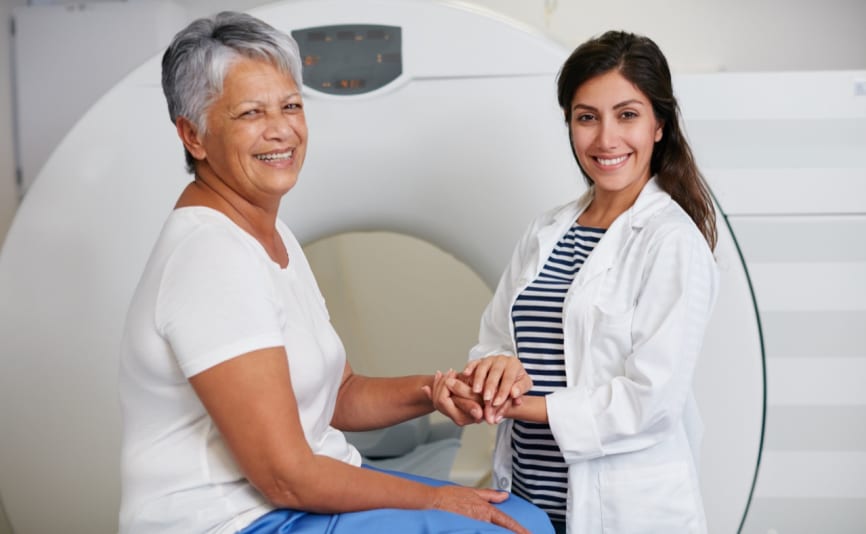Guest post in collaboration with Mr Mustafa Alnaib MBChB MRCS MSc FEBOT
Mustafa Alnaib is a doctor, orthopaedic surgeon, and musculoskeletal specialist with over 15 years of experience. He treats patients for back pain at ACTIVATE | Musculoskeletal Clinic, his practice in Kent. Scan.com are pleased to partner with him to bring you this comprehensive guide to back pain, and how medical imaging is vital for accessing the right diagnosis and treatment pathways.
What are the causes of back pain?
Back pain can have many causes, and can commonly be the result of an injury such as a muscle sprain. Sometimes, other conditions like a slipped disc, trapped nerve or arthritis can lead to back pain, and other symptoms like numbness or tingling.
Very rarely, back pain can be a sign of a more serious problem such as a fracture, cancer or an infection. MRI scans can help your clinician to rule out certain issues, or confirm a diagnosis to help you access the onward care you need.
Why would a doctor or clinician order an MRI scan for back pain?
An MRI back scan is the gold standard imaging modality for the spine. This is because MRI scans can provide high quality images of a range of different body tissues all in one image, such as soft tissues and bones. It is also a safe and non-invasive procedure, with no radiation involved.
MRI is highly sensitive and specific for diagnosing spinal conditions including cord or nerve compressions, infections, cancer and fractures. However, a CT scan is the gold standard for diagnosing and planning the management and treatment of spinal fractures.
While X-rays can also be useful for diagnosing fractures and other bone abnormalities, they are not as reliable as MRI scans for diagnosing disc, spinal cord or nerve problems. Moreover, MRI scans can also demonstrate problems in the bones of the spine (vertebrae) in more detail.
What does an MRI Scan show in the back, and what can it tell us about the causes of back pain?
MRI scans have high sensitivity and specificity in picking up many conditions affecting the spine. A good example is back pain that is accompanied with leg weakness or numbness – often an indication that there is a condition affecting the spinal cord or the nerves, like a disc prolapse or narrowing of the spinal canal.
MRI scans for back pain can also be used to identify conditions including arthritis, infection or trauma, and tumours to the spine. It can also tell us quite reliably whether a patient has spinal cancer or not.
What are the different types of spinal MRI scans?
The area of your spine that needs scanning will depend on your symptoms, and you might need to book an MRI of the whole spine in some cases. The three common spinal MRI scans are:
- Cervical spine - the neck region, consisting of the first 7 vertebrae between the skull and the base of the neck.
- Thoracic spine - the middle of the back, and the longest part of the spine, comprised of 12 vertebrae from around the top of the shoulder area down to the abdomen. The thoracic spine also connects to the rib cage.
- Lumbar spine - the lower back, made up oft 5 vertebrae between the ribs and pelvis
- Sacral spine - the lower end of the spine, comprising of 5 vertebrae and articulating with the pelvis via the sacroiliac joints on both sides
Scan.com also offers separate scans of the sacroiliac joints and coccyx (tailbone at the base of your spine).
How long does an MRI of the back take?
If you are having one section of the spine scanned, it will usually take between 10-30 minutes, and can last longer if a contrast agent is required. A scan of the whole spine can last from 30-60 minutes.
Learn more about contrast agents for MRI scans in our comprehensive guide.
How much does a back MRI scan cost?
An MRI scan on the back cost comparison is available via Scan.com - your MRI back scan will vary in price based on the area being scanned, the location of the scanning centre, and their individual prices.
For example, a lower back MRI cost will start from £295, while a full spine scan can start from £620 - covering the lumbar, thoracic, and cervical spine. An MRI back scan does not usually need to be done with contrast, but if it is, additional fees can apply of up to £150.
What scan is best for back pain?
While we’ve discussed MRI scans of the spine, there are a range of other scans for back pain, and you might be wondering whether to choose a CT vs MRI for back pain, or even if an X-ray or ultrasound will get you the answers you need.
Booking your back scan with Scan.com includes a pre-scan call with an experienced clinician, who will help make sure you get the right scan for your needs. Even if you’re not sure what scan is best for back pain, we recommend booking what you think is the right option, and our clinical team will discuss your symptoms with you to ensure you are referred for the right imaging for your needs.
CT vs MRI for back pain
Whether you choose an MRI or CT scan for back pain depends on your symptoms, and the situation that may have caused them. If you have experienced trauma of the spine, such as in a car accident, or believe you may have a fracture, a CT scan is a quick way to scan the bones of the spine, taking just a few minutes vs the 30+ minutes an MRI can take. CT generally creates bony detail better than MRI. Also, if you have metal hardware in your spine, a CT scan would usually be more suitable because it does not use magnets like MRI does.
An MRI would usually be more suitable when the injury or pain could be spinal cord related, such as stenosis, or if the issue is related to soft tissues such as ligaments or herniated (slipped) discs.
How can ultrasound for back pain be used in diagnosis and treatment?
While a back ultrasound is not usually useful for the diagnosis of back pain, it can be used to guide injections into the spine as part of your treatment plan. This is done by holding an ultrasound probe on your back while injecting a steroid, painkiller or lubricating substance into the spinal area to improve your range of motion or level of pain to help aid your recovery.
Ultrasound for back pain can be used to identify some congenital spinal disorders in young children, but for adults, MRI is the recommended modality for diagnosing spinal problems.
X-ray for back pain
What does an x-ray show for lower back pain? Well, usually an X-ray scan on the spine will be done as an initial investigation to check for fractures, broken bones, arthtitis, degeneration, or even tumours. It can also be used to show abnormalities in the curvature of the spine. Sometimes, further imaging is required after an X-ray scan to make a more detailed diagnosis.
How much does a back x-ray cost in the UK?
X-ray scans tend to be cheaper and more widely accessible than other imaging modalities for the spine. However, as mentioned, they may need to be followed up with further imaging. In the UK, our X-ray private back scan costs start from £105 and include 2 clinician consultations.
What treatments are available for different types of back pain?
Many back pain symptoms are caused by lifestyle factors, such as poor posture, sitting for too long, and working in roles that require bending or lifting. To treat these kinds of issues, lifestyle adjustments such as increased movement, along with physiotherapy, can help to improve symptoms.
Painkillers can also be taken to manage pain during the course of treatment.
Guided injections or surgery might be necessary to treat the causes of back pain. If a tumour is discovered, further tests may be required to determine the best treatment pathway and prompt referral to specialist centres.
In some cases of lower back pain, MRI shows nothing of concern within the results. This can be frustrating, but additional tests using other imaging modalities can help reveal what may be causing your pain.
How important is it for clinicians to be able to access imaging for their patients as part of their treatment programmes?
Timely, convenient and affordable access to MRI is invaluable, as it speeds up the process of diagnosing back problems, and helps guide management and plan treatments that are personalised to the patient.
Next steps
- Find out more about cervical spine, thoracic spine and lumbar spine MRI scans by visiting our body parts directory.
- Book a spinal MRI scan today, to get the diagnosis and peace of mind you need.
- Learn more about our partners at ACTIVATE | Musculoskeletal Clinic by visiting their website, or the Scan.com Partners page.
Sources used
Johns Hopkins Medicine. (n.d.). X-rays of the spine, neck, or back. Retrieved from https://www.hopkinsmedicine.org/health/treatment-tests-and-therapies/xrays-of-the-spine-neck-or-back






